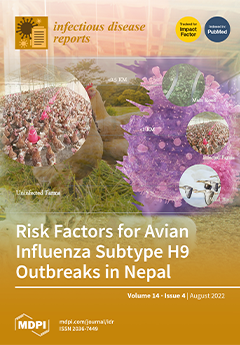Mucormycosis is a rare but serious fungal infection caused by a mold family known as the Mucorales. These fungi exist throughout the environment, especially in the soil, leaves, compost piles, or decaying woods. Humans contract mucormycosis by coming in contact with the spores
[...] Read more.
Mucormycosis is a rare but serious fungal infection caused by a mold family known as the Mucorales. These fungi exist throughout the environment, especially in the soil, leaves, compost piles, or decaying woods. Humans contract mucormycosis by coming in contact with the spores from fungus either by inhalation or through cuts on the skin. The population at risk for this life-threatening infection includes diabetes mellitus patients, cancer patients, premature infants, burn patients, and immunocompromised patients. The fungi that most commonly cause mucormycosis are the
Rhizopus species, and the least represented are
Apophysomyces species. Common clinical manifestations of mucormycosis include pulmonary, cutaneous, rhinocerebral, and gastrointestinal mucormycosis. Cases of lung mucormycosis are often misdiagnosed because of non-specific clinical symptoms and radiological features, and in many cases, have been diagnosed as
aspergillosis due to similarities in signs, symptoms, and imaging presentation of the lungs. We present a pediatric case of a 6-year-old from Togo who presented to our hospital in Nigeria with dyspnea, fever, and abdominal pain of five-day duration. The child’s symptoms began 6-months prior, with dry cough, fever, fatigue, and chest pain and abdominal pain. The hospital in Togo where he lived suspected infection with tuberculosis (TB) despite a false-positive Mantoux test and negative chest X-ray. He was initially treated for TB with Isoniazid and vitamin B6 and was discharged home. Six months later, his symptoms have not improved, but became more severe with high grade fever 40 °C (oral reading), anorexia, fatigue, tachypnea, abdominal distention, and cough. The patient was immediately referred to our hospital in Abuja, Nigeria where more specific tests were ordered. He was eventually diagnosed with chronic granulomatous disease induced pulmonary and gastrointestinal (GI) mucormycosis due to
Rhizopus spp. In this report, we discuss an unusual clinical presentation of an infection caused by
Rhizopus spp., its management, and outcomes in a child with chronic granulomatous disease (CGD).
Full article






